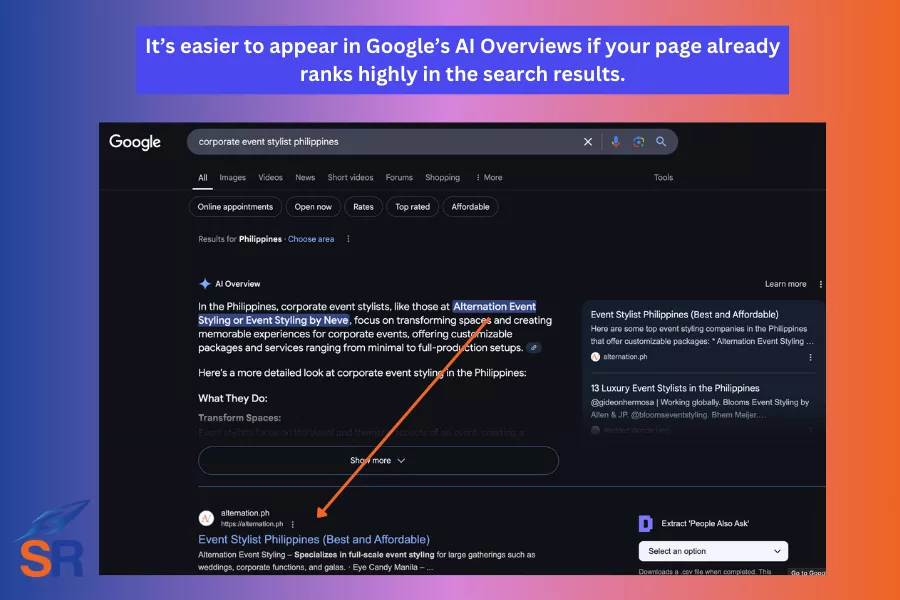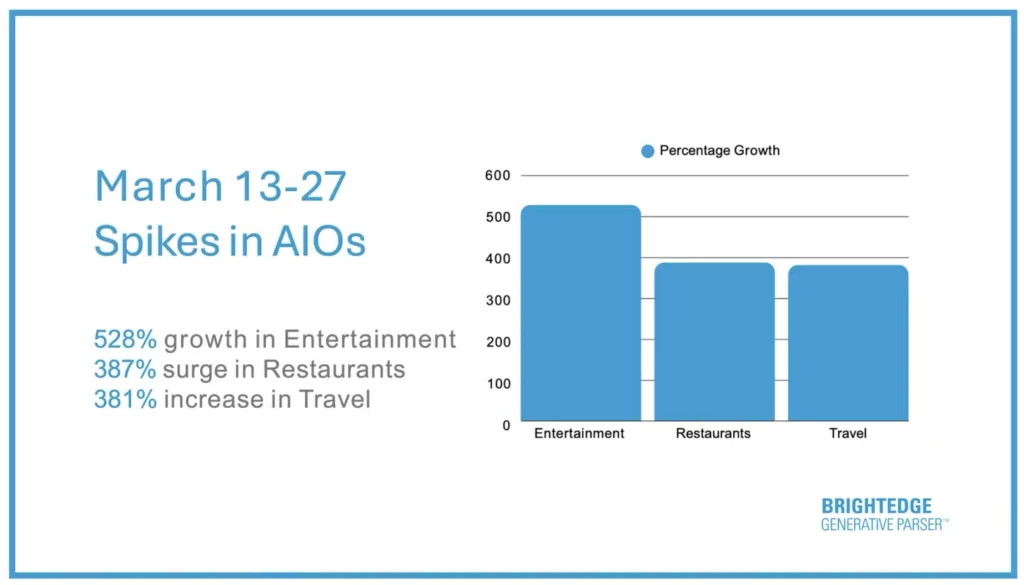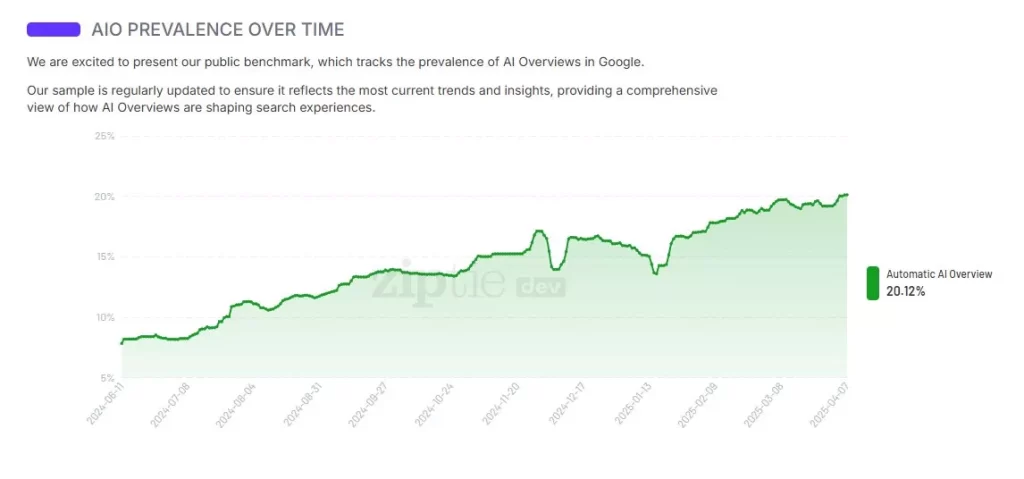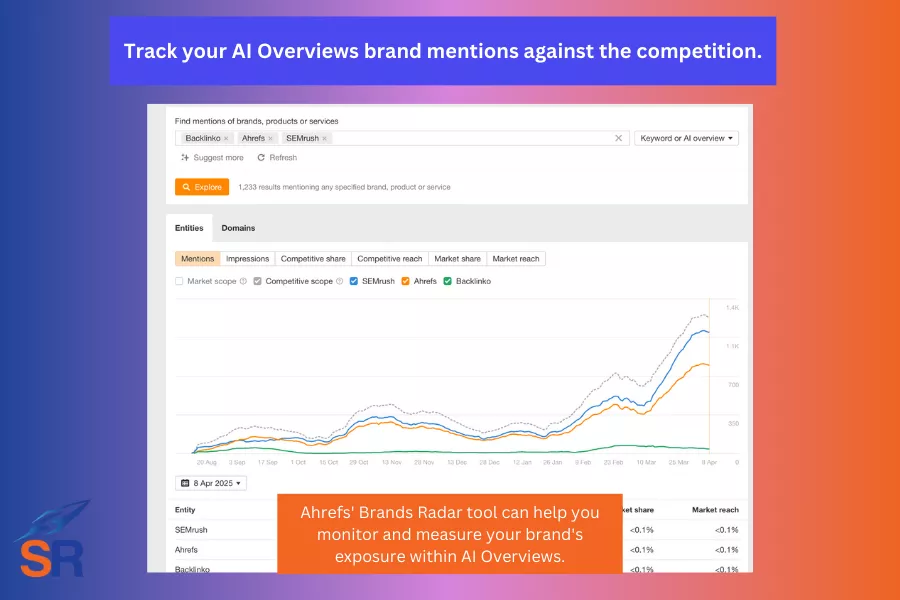by Venchito Tampon Jr | Last Updated on April 8, 2025
Google’s AI Overviews (AIOs) are now a major part of search. In the March 2025 core update, AIOs expanded sharply across entertainment, restaurants, and travel, appearing more often at the top of search results.
According to recent analysis by Glen Gabe, AIO visibility has crossed 20% for the first time ever. Verticals like real estate and eCommerce are also starting to see growth in AIO exposure. This only shows a clear shift that Google is giving more space to AI-generated summaries, and businesses need to adapt.
What are Google AI Overviews?
Google AI Overviews is a search feature that uses generative AI to give users quick, summarized answers at the top of search results. It is powered by Google’s Gemini AI model, which uses advanced reasoning and can process text, images, and other media to create detailed summaries.
Instead of clicking through multiple websites, users get a direct answer pulled from trusted sources across the web. These summaries are designed to save time and improve the search experience.
In this post, I decided to make a detailed practical guide on how to rank for AI overviews.
1. Achieve Top Rankings on Organic Search Listings
To appear in Google’s AI Overviews, your first goal should be to rank high in traditional search results. One common misunderstanding is that AI-generated content pulls from a completely separate pool of information.
In reality, AI Overviews rely heavily on the same top-ranking pages that appear in the main search engine results pages (SERPs). Though I’ve seen SERPs with AI Overviews pulling data from websites on page 2, ranking on AI Overviews is much easier if you’re within the top rankings for your target keywords.

Google’s AI system scans trusted, authoritative sources and those that are usually the pages already ranking well. The AI then summarizes key points from these sources to generate the overview shown at the top of the results.
To increase your chances of being included:
- Focus on strong on-page SEO fundamentals. Optimize target keyword in titles, headers, URL structure, and write for a better contextual understanding of your page.
- Match the search intent precisely. Give direct, clear, structured answers if the query is informational. Avoid fluff and vague explanations.
- Use question-style subheadings (e.g., “What is..?”, “How does…?”) and follow them with accurate, concise answers (these are the types of structure that make it easier for Google’s AI to extract useful information).
- Improve UX by fixing technical issues. On one of my own sites, after fixing its Core Web Vitals issues, it directly helped surface in AI Overviews.
Without these basic hygienic optimizations, your content won’t be in the running for AI Overview inclusion.
2. Reverse Engineer the Sources That Feed AI Overviews
To increase your likelihood of appearing in Google’s AI Overviews, you need to understand where the AI pulls its information from and how to get your brand mentioned in those places.
AI Overviews rely on a mix of high-ranking sources, link mentions, and even unlinked brand references to build accurate and context-rich summaries. Unlike traditional snippets that pull from a single page, AIOs synthesize insights from multiple authoritative sources.
Here’s how to reverse-engineer these sources and improve your brand’s visibility and presence:
Search like your customers. Use queries like “best [product type] for [use case]”, “[competitor] alternatives”, or “top [industry] tools”. Look at what pages appear in those search engine results pages.
Create an inventory of the content types that consistently appear. You’ll often find these content types and structures:
- “Best of” listicles
- Review platforms (e.g., for SaaS keywords, software review platforms include G2, Capterra, and TrustRadius)
- Industry-specific blogs and trade publications
- Media outlets that Google considers reliable and trustworthy
Once you have a list of these sources, you can launch a digital PR campaign and strategic link building campaign that gets you mentioned or linked from these sources (don’t ignore unlinked brand mentions, as they can also influence what AI Overviews include).
Google’s AI values context, credibility, and diversity of input. When your brand is mentioned across multiple high-authority sites, especially in comparison-style or recommendation-focused content, it signals trust, and that increases your chances of showing up in AI-generated answers.
3. Feed AI Overviews with the Right Content Types
This tip builds on the previous strategy. While it’s important to get your brand mentioned by external sources, it’s just as critical to publish the kind of content AI overviews are likely to use.
You can focus on publishing content types to help Google AI Overviews easily extract and summarize key information from your site. These content types should be structured, relevant, and optimized for clarity, making it easier for the AI to pull accurate insights and display your content in search overviews.

Start with high-impact formats such as:
- List-style content: Posts like “Best Tools for [X]”, “Top Alternatives to [Competitor]”, or “Best Software for [Use Case]” to give Google clear comparisons and structured information, which are ideal for summary generation.
- Comparison pages: Content such as “[Your Brand] vs [Competitor]” provides side-by-side breakdowns of features, pricing, and benefits, now being used in AI Overviews given that they answer common buyer-intent questions directly.
- Feature-focused landing pages: Create separate, well-structured pages for each product, service, or solution and optimize them better to satisfy searchers’ intent and needs by including clear headers, bullet points, and FAQs that explain key benefits, integrations, and use cases.
- FAQ and FUQ hubs: Publish dedicated FAQ and FUQ (Frequently Unasked Questions) pages that address specific questions your target users are likely to search for answers yet, but are not commonly asked. Then, format these answers clearly and include keywords naturally for better relevance.
- Use-case and industry pages: Showcase how your product or service solves problems for specific industries, avatars, or roles, helping it to match long-tail, intent-based queries that are often pulled into AI Overviews.
The main objective is to mirror the types of sources that AI Overviews pull from while structuring your content to make it easy to scan, cite, and summarize.
By creating a content library of these assets on your site, you improve your site’s visibility in traditional search and feed the AI system exactly the type of content it looks for when generating search overviews.
4. Include Original Data and Insights
One of the most effective ways to stand out in Google’s AI Overviews (and I’ve tested it a couple of times) is by adding original information that provides real value beyond what’s already on the web (“information gain”).
Information gain refers to the idea of content that should offer something new, not just rephrase what already exists. It should be based on actual experiences and expertise that happen in the offline world.
To achieve this, you can focus on publishing content assets that include:
- Original research or surveys
- Proprietary data or performance metrics (every industry tracks performance)
- Expert commentary or quotes from subject matter experts (SMEs)
- Case studies with measurable outcomes
- Unique analysis or trends not commonly cited elsewhere
When crafting these content assets, I’d like to improve the reading experience for my target audience. Here are the critical steps to do it:
- Use clear formatting such as bullet points, tables, and visuals to make your insights easy for AI to process and summarize.
- Cite sources and credentials. If you’re quoting an expert, include their name, title, and relevant background to establish authority.
- Include a brief methodology for any study or data you present.
Let your site’s content library add to the body of knowledge on the subject matter of your choice (always bring something new to the table).
5. Increase Visibility in the Entire SERP Ecosystem
The SERP ecosystem is now filled with multiple content types and platforms, all of which can influence what appears in AI Overviews. Search for any high-value keyword, and you’ll see a crowded SERP.
To improve your brand’s chances of appearing in AI Overviews, you need to increase your brand’s presence across all relevant SERP elements (not just organic links to your own domain).
Here are actionable tips to consider a holistic SEO (and brand marketing) approach:
- Create, optimize, and publish video content, helping it rank in carousels and be referenced in AI-generated summaries.
- Join discussions on Reddit. Add value to the discussions and relevant threads or subreddits where your target audience hangs out (as you know, Reddit posts often appear in search results and are now cited in AIOs). Check out this guide on using Reddit for SEO and content marketing.
- Leverage multi-format content by turning blog posts into videos, infographics, and interactive content to allow your content to show in various result types.
Increase the number of touchpoints your brand has in the SERP, as this can significantly affect your exposure to both users and Google’s AI systems.
6. Optimize For Content Depth and Better Content Structure
Content depth isn’t about writing longer content to reach a certain word count. It’s about writing complete and relevant content that answers your audience’s real questions.
AI Overviews pulled information from sources that demonstrate strong topical coverage. This means that your content should go beyond surface-level information and directly address the types of questions your ideal customer profile (ICP) would ask (even if those queries don’t have high search volume).

I’ve seen SERPs with AI Overviews that have been pulling content from lower domain rating websites, as long as the specific page covers the topic comprehensively and clearly. Now, it gives chances for smaller brands to compete if they genuinely provide content depth and better structure.
Here’s how to optimize your content for content depth and structure:
- Use conversational phrasing and real questions. Structure headers as questions your audience would ask, and provide succinct, clear answers to each question.
- Organize content for scanning and summarization. Use bullet points, numbered lists, and short paragraphs (making it easy for the AI to understand and extract value).
- Implement schema markup (like FAQ schema, HowTo, Review, Article, etc..) to help Google better understand your content’s purpose and format.
- Highlight unique insights or complete coverage—make your content more comprehensive than other sites’ “ultimate guides” pages.
If you focus on clarity, topical completeness, and proper content formatting, even if you’re a small site, you can become a go-to source for highly sub-niche topics for Google’s AI-generated summaries.
7. Track Your AI Overview Brand Mentions Against The Competition
As AI-generated summaries often answer user queries directly, you’ll notice a reduction in the number of clicks to individual websites (as users instantly consume the content right from Google without clicking the websites, even when those sites are the source of the information).
One way for brands to become competitive is to track how often they’re mentioned in AI Overviews and how that visibility stacks up against competitors. Tools like Ahrefs’ Brand Radar have become valuable in this matter. Though they’re still in Beta mode as of this writing, it can help you generate the data and insights you need to track a brand’s standing on AI Overviews.
Ahrefs’ Brands Radar tool can help you monitor and measure your brand’s exposure within AI Overviews. Here’s what it enables you to do:
- Monitor your market’s AI search activity. See how frequently AI Overviews appear for questions and phrases related to your primary keyword, and identify if those queries are driving those results.
- Track your brand mentions in AIOs over time. Understand how often your brand is cited, referenced, or included in AI-generated summaries across key topics.
- Compare visibility against competitors. Benchmark your brand’s AIO presence next to other companies in your space, which will help you spot gaps and competitive advantages.
- Identify new AIO content opportunities. Analyze which types of content get pulled into Overviews and adjust (or add more efforts) to your content strategy to target similar formats or topics.
- Monitor brand sentiments in AIOs. Check whether your brand is being mentioned in a positive, neutral, or negative context within AI responses (giving you insights into public perception as reflected by AI systems).
You need a clearer and bigger picture of your true brand reach in search Overviews beyond clicks and impressions.
There you go, seven actionable tips to help you rank for AI Overviews. If you need help with search engine optimization or link building, send us your needs, and we’ll be glad to help.
The Author
Venchito Tampon Jr
Venchito Tampon is a Filipino Motivational Speaker, Corporate Trainer, and a Leadership Speaker in the Philippines. He is the CEO and Co-Founder of SharpRocket, a link building agency. With a decade of experience, Venchito has a proven track record of leading hundreds of successful SEO (link builidng) campaigns across competitive industries like finance, B2B, legal, and SaaS. His expert advice as a link building expert has been featured in renowned publications such as Semrush, Ahrefs, Huffington Post and Forbes. He is also an international SEO spoken and has delivered talks in SEO Zraz, Asia Pacific Affiliate Summit in Singapore, and Search Marketing Summit in Sydney, Australia. Check out his other businesses, Hills & Valleys Cafe, Blend N Sips and Saas Pursuit.
How our LINK BUILDING AGENCY builds 250 links/mo consistently using Predictable Link Building Methodology™…
- Using a SIMPLE and PROVEN system
- Using a SCALABLE strategy
- No private blog networks
- No creepy outreach emails



